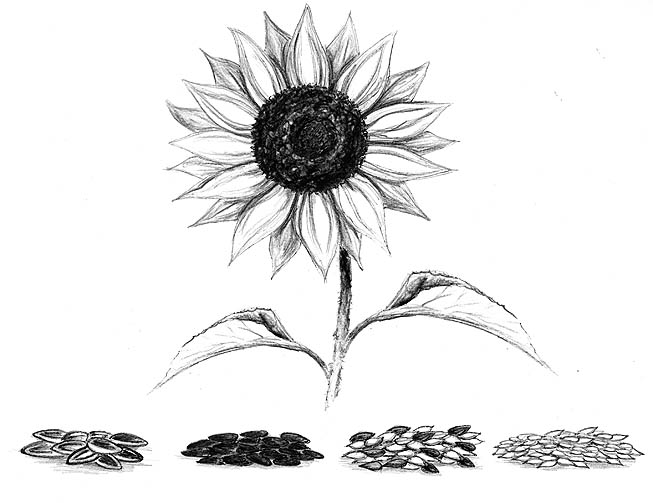
Dear Bird Folks,
I took your advice and decided to fill my bird feeders with 100% sunflower seeds. But my local birding store offers several types of sunflower, including some without shells. Which is the best? Also, how are they able to get the shells off the seeds?
– Don, Wayne, NJ
It’s easy, Don,
For years taking the shells off sunflower seeds was a huge problem. Then some creative manufacturer got Major League Baseball involved. The company hires old, retired ballplayers and has them spend their entire day chewing on sunflower seeds. Ball players are masters at snapping off the shells with their teeth. Once the shells are removed the players spit the separated sunflower meats into a nearby bucket. This process is slow, but it’s fairly efficient. It’s also the main reason why you should always wash your hands after filling your feeders.
While I admit some of the information in the opening paragraph isn’t totally accurate (and by “some” I mean all), there are a few true facts about sunflowers you might not know. Today sunflowers are grown all over the world, but this plant’s continent of origin is good old North America. Native Americans used sunflowers for centuries, but it had little appeal to non-native Americans. They were too busy eating buffalo steaks and eliminating Passenger Pigeons. Spanish explorers were the first to introduce sunflowers to Europe, where it was well received. Tasty sunflower seeds were especially welcomed by Peter the Great of Russia, who was getting tired of eating beets all day. Sunflowers also received a boost from the Russian Orthodox Church. The Church usually banned the use of most oils during Lent, but it was totally cool with sunflower oil. So, to keep the Church happy, the Russians cooked their beets in sunflower oil. Sunflower production benefited greatly by the varieties produced by famed Russian researcher Vasilii Stepanovich Pustovoit (but you probably already knew that). Vasilii was so outstanding in the sunflower field (ha!) that the Pustovoit Award is annually given for exceptional work in the sunflower industry. Really. (Good old Vasilii.) Eventually, Russian immigrants brought the new and improved sunflower plants back to America and this time we paid attention (mostly because the buffalos were all gone). Now sunflower seeds are used for oil, in cattle silage, by hippies in health food stores and most importantly, to feed birds. Thank goodness for that last one.
When it comes to feeding birds, there are four basic choices of sunflower seeds. The least popular is “striped” sunflower seed. As the name implies, these seeds have stripes on the shells. The black and white stripes make the seeds look pretty, but the shells tend to be heavy and thick. And since the seeds are sold by the pound, we pay for the thick, heavy shells, which always end up on the ground. The better option is “black oil” sunflower. Black oil sunflower is so named because the shells are black and the meat has a high oil content. In addition, the black shells are extremely thin and that results in a better buy for consumers and more edible food for birds.
Over the last decade another form of sunflower has become popular with both people and birds – “hulled” sunflower. Like pitted prunes and seedless watermelons, hulled sunflower is a modern miracle. With hulled sunflower we don’t have to worry about a big mess of empty shells on the ground because everything is eaten. However, hulled sunflower seeds (also called sunflower “hearts,” sunflower “chips,” and “seedless” sunflower by one strange customer) aren’t perfect. One problem is the cost. Hulled sunflower can be double the price of black oil. The other problem is that without the hulls to protect them, the “meat” of the sunflower is susceptible to moisture. Hulled seeds can spoil or become sticky and jam feeders after a period of rain or high humidity. And when this happens, you know whose fault it is, don’t you? Mine, of course, as usual.
The fourth and less common option is called “No. 2” sunflower seed. In order to remove the shells from the meat, manufacturers run sunflowers through dehullers. Dehullers blast the seeds against steel plates and that causes the seeds to split open. The seeds then pass through a series of sifters, electronic eyes and streams of air, which separates the empty shells from the meat. Like any manufacturing procedure, this process isn’t perfect and sometimes not all the shells are removed. These rejected batches of seeds are shipped off to the bird feeding industry. No. 2 sunflower is usually a good buy. It contains far less waste than black oil sunflower and costs considerably less than hulled sunflower. That’s the good news. The bad news is that No. 2 seed is a byproduct and thus the quality can vary. Sometimes it’s very clean, other times not so much. When it’s clean no one says a word, but when it’s “not so much” you know whose fault it is, don’t you?
Birds love any and all sunflower seed, Don. Black oil is a fine choice if you don’t mind a little mess on the ground under your feeders. If you are a neat freak and have the extra cash, go with hulled sunflower. Hulled sunflower is 100% edible, yummy goodness. I’m sorry if you were confused by all the sunflower choices, but don’t let the bullies in your local birding store intimidate you. Just walk in and tell them you want the seed Vasilii Stepanovich Pustovoit invented. That will shut them up.